
MOVE
Are you golf fit?
Posted July 27, 2018
Golf season is in full swing. But is an injury or pain keeping you from the course?
Golf is a sport, and golfers, like any athlete, need to be in shape to play well and reduce the risk of injury. The most common golfing injuries are to the muscles, joints and tendons in the back, shoulders, elbows and wrists, with the back being the number one site of injury. Professional golfers are more likely to suffer from overuse injuries, while the typical amateur's injuries are more acute and can be caused by:
- Poor physical condition
- No pre-game preparation or warmup
- Poor swing mechanics
- Incorrect grip and set up
If you have an injury or experience pain and cannot play your favorite game, your first step is to determine the cause. Maybe you spent all winter watching golf on television and as a result are out of shape? Maybe you pulled a muscle because you didn't warm up before swinging hard on the first tee? If you are injured or out of shape, check with your health care provider to treat the injury or to ensure your health is good enough to start a fitness program.
Be prepared
A proper fitness program for golfers includes an aerobic activity (walking, running, biking) at least three times a week. After all, golfers who walk an 18-hole course typically put on between 6 to 8 miles per round.
In addition, your routine should also include strength training. Not only will this improve your fitness in general, but it may lower your golf score.
Be sure to start your round of golf with a proper pre-game warmup. Do at least 10 minutes of activity, such as a brisk walk. Then add some stretches for your hands, wrists, forearms, elbows, shoulders, spine and pelvis. Swing your golf club a few times slowly and gradually increase your range of motion and speed of your swing.
Stretching: not just for warm-up
One of the best ways to treat or prevent a golfing injury is with regular stretching. Stretching can help rehabilitate an injury and increase your flexibility. Some of the best stretches are done on a foam roller. When you use a foam roller, roll slowly about one inch per second to get the most benefit. In addition, do not use the foam roller directly on your lower back as this can cause injury. Instead, work your upper back, hips and gluts (buttocks). If, while rolling, you find a sore spot, pause for 30 seconds on that spot.
- Upper
back: Lie on your back with your knees bent and your feet on the ground. Place the foam roller under your shoulder blades. Cross your arms over your chest. Push down with your feet to lift your buttocks off the ground and place your weight on the roller. Roll back and forth on your upper back
slowly for about two minutes.
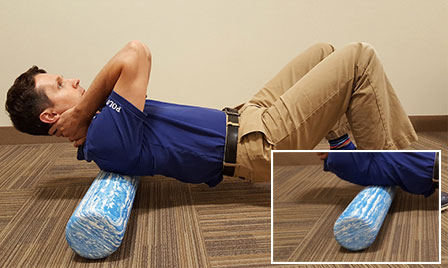
- Hips: Lie on your stomach and place the roller under your hips where your leg meets your torso. Extend your left leg straight out, and place right leg at a 90 degree angle to the side (see picture) so that you weight is on the left leg. Roll for
30 seconds and then switch sides.
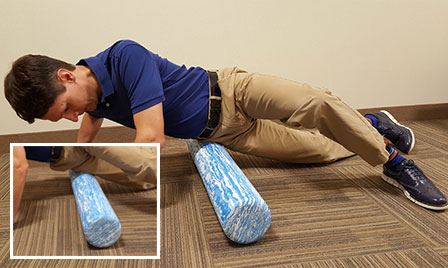
- Glutes: Sit on the ground and support yourself on your hands and feet. Place the roller under your buttocks so that you are sitting on it. Raise one leg and place the ankle of that leg on your knee. Keep most of your weight on the roller and gently roll across the roller for 30 seconds. Switch legs and roll again.
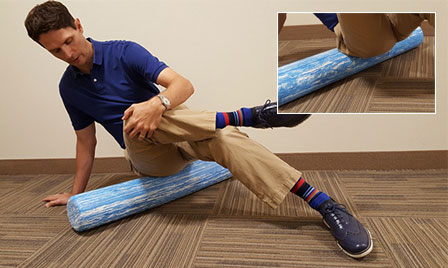
If you don't have a foam roller, there are alternative stretches that can help.
- Cow/cat: This yoga stretch will help your mid-back. Get on your hands and knees, with your arms directly below your shoulders and your knees below your hips. Keep your head in a neutral position. Inhale and lower your belly towards the ground as you lift
your chin and chest (cow position). Hold, then reverse as you exhale and draw your belly toward your spine and round your back toward the ceiling. Your head should drop toward the floor (cat position). Inhale and come back to the cow position. Repeat.
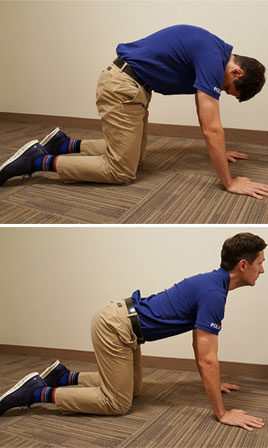
- Half-kneeling
stretch: Kneel on your right knee and place your left leg forward and bent at 90 degrees. Place your hands on the thigh of your front leg and push down slightly. Squeeze your glutes and drive your hip forward keeping your back straight (don't bend or extend your back). Hold the stretch for 30 seconds and
repeat with your right leg forward and your left leg bent.
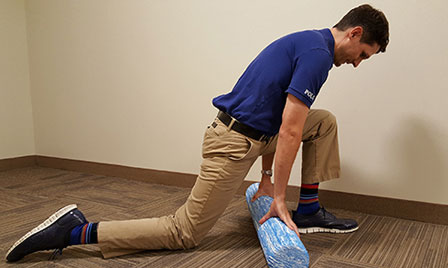
- Sitting hip
stretch: Sit in a chair. Cross the ankle of your left foot over your right knee. Lean forward from your hips until you feel a stretch and hold for 30 seconds. Repeat with your right ankle over your left knee.
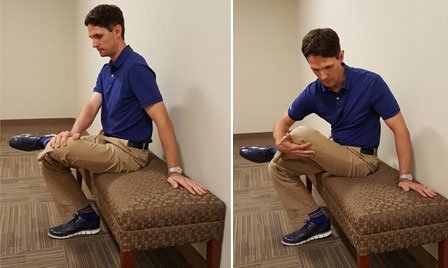
- Hamstring stretch: Sit in a chair or stand holding onto a golf club if you need to for balance. Place your left leg out straight with your toes pointed up and lean forward from your hip until you feel a stretch in the back of your left leg and hip. Hold for 30 seconds
and repeat with the opposite leg.
Get help
These stretches will help if you are trying to recover from or prevent an injury, or are trying to improve your fitness. But if your problems are caused by incorrect swing mechanics or a bad grip, you may want to see a golfing pro to help you refine your technique.
-
Golfsmart
Schedule an appointment
MORE ARTICLES LIKE THIS
Get fun, inspiring, provider-reviewed articles sent to your inbox.
Sign up for our email newsletter




